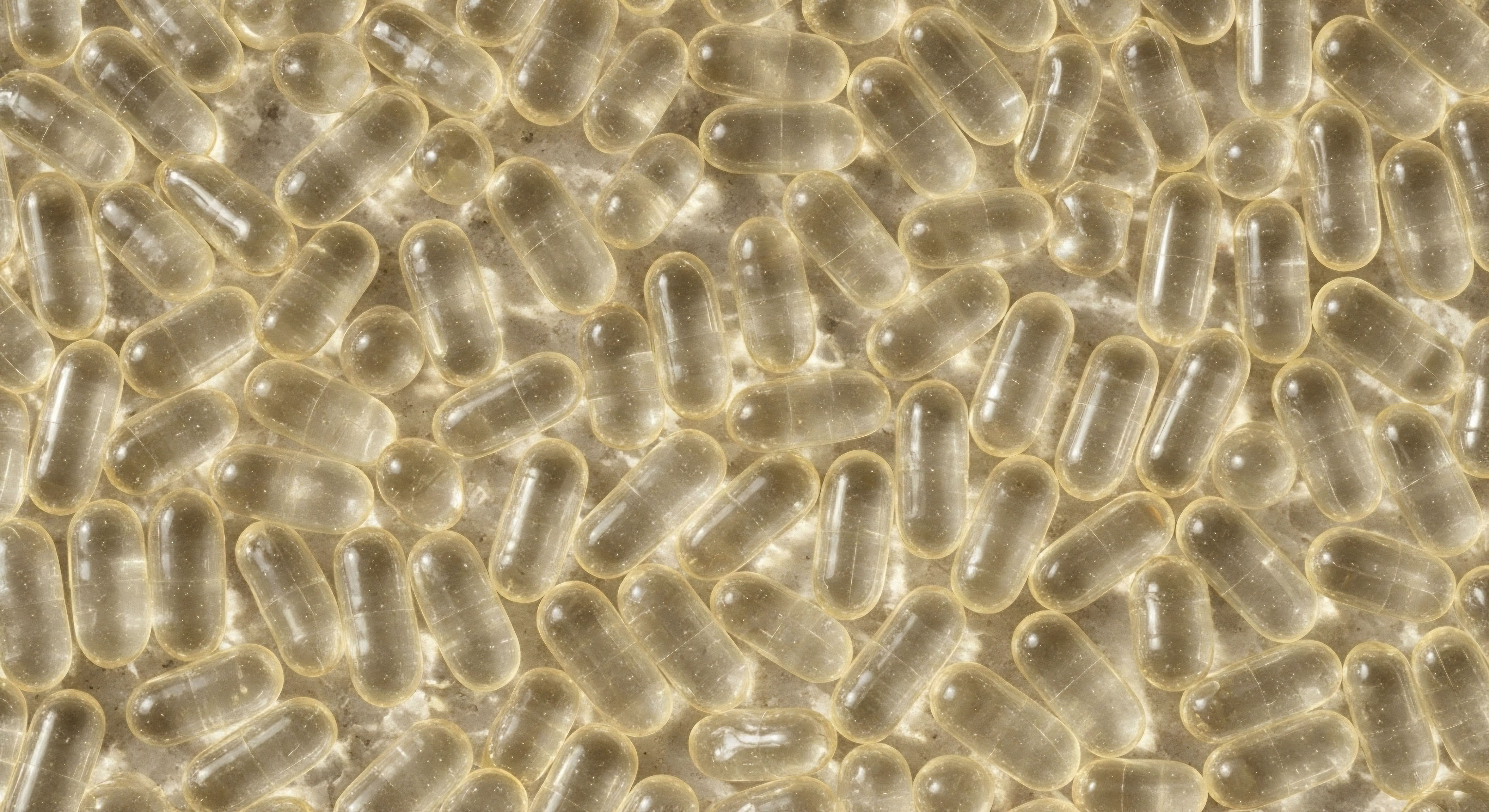


Fundamentals
Perhaps you have experienced a subtle shift in your vitality, a quiet erosion of the energy and clarity that once felt inherent. Perhaps the mornings feel heavier, the drive less potent, or the emotional landscape more turbulent. These sensations, often dismissed as inevitable aspects of aging or stress, frequently signal a deeper conversation occurring within your biological systems.
Your body communicates through a complex symphony of chemical messengers, and when this communication falters, the effects ripple through every aspect of your well-being. Understanding these internal dialogues marks the initial step toward reclaiming your inherent vigor.
At the heart of this intricate communication network lies the pituitary gland, a small but profoundly influential organ nestled at the base of your brain. Often called the “master gland,” it orchestrates the release of many hormones that govern growth, metabolism, reproduction, and stress response. This tiny structure receives signals from the hypothalamus, forming the critical hypothalamic-pituitary axis, which then sends its own hormonal directives to other endocrine glands throughout the body. When this central command center functions optimally, a cascade of balanced biochemical events supports robust health.
Traditional hormone replacement therapy, or HRT, typically involves introducing exogenous hormones ∞ substances identical or similar to those naturally produced by the body ∞ to compensate for a deficiency. For instance, if the testes or ovaries produce insufficient testosterone or estrogen, HRT directly supplies these hormones. This approach aims to restore circulating hormone levels to a physiological range, thereby alleviating symptoms associated with their decline. It is a direct and well-established method for addressing hormonal insufficiency.
Reclaiming vitality begins with understanding the intricate hormonal conversations within your body, particularly those orchestrated by the pituitary gland.
Peptides, by contrast, represent a distinct class of biological molecules. These short chains of amino acids act as signaling agents, often prompting the body to produce its own hormones or modulate existing biological processes. Instead of directly replacing a hormone, many therapeutic peptides work upstream, influencing the pituitary or other glands to synthesize and release hormones more effectively.
This distinction highlights a fundamental difference in how these two therapeutic avenues interact with your endocrine system. Peptides can be seen as biological conductors, guiding the body’s own orchestra to play in harmony.
The pituitary gland’s activity is subject to regulation by various peptides. For example, gonadotropin-releasing hormone (GnRH), a decapeptide produced by the hypothalamus, stimulates the pituitary to release luteinizing hormone (LH) and follicle-stimulating hormone (FSH). These gonadotropins then travel to the gonads, influencing testosterone production in men and estrogen and progesterone synthesis in women.
Other endogenous peptides, such as somatostatin and growth hormone-releasing hormone (GHRH), similarly regulate the pituitary’s release of growth hormone. This complex interplay underscores the pituitary’s responsiveness to subtle peptide signals.
Considering the differences between traditional hormone replacement and peptide-based strategies requires an appreciation for their respective mechanisms. While HRT offers a direct replenishment, peptides often offer a more nuanced approach, working with the body’s inherent regulatory systems. This distinction becomes particularly relevant when considering the long-term health of the endocrine system and the desire to support endogenous function where possible.



Intermediate
When considering interventions for hormonal balance, the choice between traditional hormone replacement and peptide therapies often depends on the specific physiological need and the desired mode of action. Traditional hormone replacement therapy, such as Testosterone Replacement Therapy (TRT), directly introduces bioidentical or synthetic hormones into the system. This approach is highly effective for conditions where a gland’s capacity to produce a hormone is significantly diminished or absent.


Testosterone Optimization Protocols for Men
For men experiencing symptoms of low testosterone, such as diminished energy, reduced libido, or changes in body composition, TRT offers a direct path to restoration. A common protocol involves weekly intramuscular injections of Testosterone Cypionate, typically at a concentration of 200mg/ml. This method ensures consistent levels of the hormone, alleviating the pervasive symptoms of hypogonadism.
Managing estrogen levels is a key consideration in male TRT, as exogenous testosterone can convert to estradiol via the aromatase enzyme. Elevated estrogen can lead to undesirable effects like gynecomastia or water retention. To mitigate this, an aromatase inhibitor such as Anastrozole may be prescribed, often at a dose of 2x/week orally. Careful monitoring of estradiol levels is essential, as over-suppression can lead to joint pain, reduced bone mineral density, and adverse lipid profiles.
Maintaining testicular function and fertility while on TRT presents another important aspect. Exogenous testosterone can suppress the body’s natural production of LH and FSH, leading to testicular atrophy and impaired spermatogenesis. To counteract this, Gonadorelin, a synthetic form of GnRH, is often administered via subcutaneous injections, typically 2x/week. Gonadorelin stimulates the pituitary to continue producing LH and FSH, thereby supporting endogenous testosterone production and preserving testicular size and fertility.
Testosterone replacement in men balances direct hormone provision with careful management of estrogen and preservation of testicular function.


Testosterone Optimization Protocols for Women
Women also experience symptoms related to declining testosterone, particularly during peri- and post-menopause, which can manifest as low libido, fatigue, and mood changes. While testosterone therapy for women is often considered off-label in many regions, clinical practice frequently employs low-dose protocols to address these concerns.
A typical approach involves weekly subcutaneous injections of Testosterone Cypionate, with doses significantly lower than those used for men, often in the range of 10 ∞ 20 units (0.1 ∞ 0.2ml). This precise dosing aims to restore testosterone to a healthy premenopausal physiological range without inducing virilizing side effects. Progesterone supplementation is also a common component of female hormone balance protocols, particularly for women with intact uteruses, to support endometrial health and overall well-being. Pellet therapy, offering long-acting testosterone delivery, is another option, sometimes combined with Anastrozole if estrogen conversion becomes a concern, though careful monitoring is paramount to avoid supraphysiological levels.


Post-TRT and Fertility-Stimulating Protocols for Men
For men discontinuing TRT or actively seeking to restore fertility, a specialized protocol aims to reactivate the natural HPG axis. This typically involves a combination of agents designed to stimulate endogenous hormone production.
- Gonadorelin ∞ Administered to stimulate the pituitary’s release of LH and FSH, thereby signaling the testes to resume testosterone and sperm production. Its pulsatile delivery mimics the body’s natural GnRH rhythm.
- Tamoxifen ∞ A selective estrogen receptor modulator (SERM) that blocks estrogen’s negative feedback on the hypothalamus and pituitary, encouraging increased LH and FSH secretion.
- Clomid (Clomiphene Citrate) ∞ Another SERM that works similarly to Tamoxifen, promoting gonadotropin release and stimulating testicular function.
- Anastrozole ∞ Optionally included to manage any transient estrogen spikes during the recovery phase, ensuring a favorable hormonal environment for testicular recovery.


Growth Hormone Peptide Therapy
Peptide therapy offers a distinct pathway for modulating the pituitary, particularly concerning growth hormone (GH) secretion. Instead of directly administering GH, these peptides stimulate the pituitary to produce and release its own GH in a more physiological, pulsatile manner. This approach can appeal to active adults and athletes seeking benefits like improved body composition, enhanced recovery, and better sleep quality.
Key peptides in this category include Sermorelin and the combination of Ipamorelin / CJC-1295. Sermorelin is a GHRH analog that directly stimulates the pituitary to release GH. Ipamorelin, a growth hormone secretagogue (GHS), and CJC-1295, a GHRH analog, work synergistically to promote a sustained and robust GH release.
Tesamorelin, another GHRH analog, has specific applications, particularly in reducing visceral adipose tissue. Hexarelin, a potent GHS, and MK-677 (Ibutamoren), an orally active GHS, also stimulate GH release, often leading to increased IGF-1 levels.
The table below compares the mechanisms and primary applications of several growth hormone-modulating peptides ∞
| Peptide | Mechanism of Action | Primary Applications |
|---|---|---|
| Sermorelin | GHRH analog, stimulates pituitary GH release. | Anti-aging, general wellness, improved body composition. |
| Ipamorelin / CJC-1295 | Ipamorelin (GHS) and CJC-1295 (GHRH analog) synergistically increase pulsatile GH. | Muscle gain, fat loss, enhanced recovery, sleep improvement. |
| Tesamorelin | GHRH analog, specifically reduces visceral fat. | Visceral fat reduction, metabolic health. |
| Hexarelin | Potent GHS, increases GH and IGF-1. | Muscle growth, strength, recovery. |
| MK-677 (Ibutamoren) | Oral GHS, increases GH and IGF-1. | Body composition, sleep, appetite stimulation. |


Other Targeted Peptides
Beyond pituitary modulation, other peptides offer highly specific therapeutic actions for various aspects of wellness. PT-141 (Bremelanotide) stands out for its role in sexual health. Unlike traditional erectile dysfunction medications that act on blood flow, PT-141 works centrally by stimulating melanocortin receptors in the brain, particularly the MC4R, to increase sexual desire and arousal in both men and women. This brain-centered mechanism makes it a distinct option for addressing libido concerns.
Pentadeca Arginate (PDA), a synthetic form of BPC-157, represents a promising avenue for tissue repair, healing, and inflammation management. This peptide supports collagen synthesis, enhances tissue regeneration, and reduces inflammatory markers, making it valuable for recovery from injuries, wound healing, and supporting gut health. Its stability and enhanced absorption compared to its precursor make it a compelling option in regenerative medicine.


How Do Peptides Compare to Traditional Hormone Replacement in Their Systemic Impact?
The systemic impact of peptides often differs from traditional hormone replacement. While HRT directly elevates circulating hormone levels, potentially leading to supraphysiological concentrations if not carefully managed, peptides often work by stimulating the body’s own regulatory mechanisms. This can result in a more balanced, pulsatile release of hormones, which may more closely mimic natural physiological rhythms. The choice between these modalities hinges on whether the goal is direct replacement or the gentle recalibration of endogenous systems.
Academic
The endocrine system operates as a sophisticated network of feedback loops, where hormones and signaling molecules constantly communicate to maintain physiological equilibrium. Understanding how peptides compare to traditional hormone replacement in pituitary modulation requires a deep appreciation of these intricate regulatory mechanisms, particularly the hypothalamic-pituitary-gonadal (HPG) axis and the hypothalamic-pituitary-somatotropic (HPS) axis. These axes represent the core of hormonal control, and interventions at different points along these pathways yield distinct physiological outcomes.


Pituitary Regulation and Signaling Pathways
The anterior pituitary gland, a central player in endocrine regulation, houses specialized cells that synthesize and secrete various trophic hormones. These cells are exquisitely sensitive to signals from the hypothalamus, delivered via the hypophyseal portal system. Traditional hormone replacement often bypasses this intricate regulatory system by introducing hormones directly into the systemic circulation.
For instance, exogenous testosterone in TRT directly influences target tissues, but it also exerts negative feedback on the hypothalamus and pituitary, suppressing endogenous LH and FSH production. This suppression, while expected, necessitates strategies like Gonadorelin co-administration to preserve testicular function.
Peptides, conversely, frequently act as agonists or antagonists at specific receptors within the pituitary or hypothalamus, thereby modulating the release of endogenous hormones. Growth hormone secretagogues (GHSs), such as Ipamorelin and MK-677, bind to the ghrelin receptor (GHS-R) on somatotrophs in the anterior pituitary. This binding stimulates the pulsatile release of growth hormone, often without significantly disrupting the negative feedback exerted by IGF-1. This mechanism aims to restore a more youthful GH pulsatility, which can decline with age, rather than providing a constant, non-physiological surge of GH.
Peptides often recalibrate the body’s own hormonal production by influencing pituitary signaling, a contrast to the direct replacement offered by traditional hormone therapy.
The distinction extends to the cellular level. When GnRH (or its synthetic analog, Gonadorelin) binds to its receptors on gonadotrophs, it activates a G protein-coupled receptor cascade, leading to the production of inositol triphosphate (IP3) and diacylglycerol (DG), which, along with calcium ions, activate protein kinase C (PKC). This pathway ultimately promotes the synthesis and release of LH and FSH. The pulsatile nature of GnRH secretion is critical; continuous exposure to GnRH or its long-acting analogs can lead to receptor desensitization and suppression of gonadotropin release, a principle exploited in certain therapeutic contexts like prostate cancer treatment.


How Do Peptides Influence Endocrine Feedback Loops Differently than Traditional Hormones?
The influence of peptides on endocrine feedback loops presents a fascinating area of study. Traditional hormone replacement, by providing a steady supply of a hormone, can dampen the body’s own production through negative feedback. For example, supraphysiological levels of exogenous testosterone can lead to a profound suppression of the HPG axis. While this is often the therapeutic goal in certain scenarios, it also means the body’s natural hormonal rhythm is overridden.
Peptides, particularly those that act as secretagogues, aim to work within these feedback systems. GHSs, for instance, stimulate GH release, but the subsequent rise in IGF-1 still provides negative feedback, preventing excessive GH levels. This preservation of physiological feedback mechanisms is a key theoretical advantage, potentially leading to a more balanced and sustainable hormonal environment. The goal is to nudge the system back into optimal function, rather than to replace a missing component entirely.
Consider the case of PT-141. Its action on melanocortin receptors in the central nervous system, particularly the hypothalamus, influences sexual desire and arousal through neurotransmitter modulation, notably dopamine release. This is a fundamentally different mechanism from direct hormonal replacement or even phosphodiesterase-5 inhibitors, which act peripherally on vascular smooth muscle. PT-141’s central action highlights how peptides can target specific neural circuits to influence complex physiological behaviors, offering a more upstream intervention.


Metabolic Interplay and Long-Term Considerations
The endocrine system is not isolated; it is deeply interconnected with metabolic function, inflammation, and even cognitive processes. Hormonal imbalances, whether from deficiency or dysregulation, can manifest as metabolic dysfunction, altered body composition, and systemic inflammation.
Peptides like Pentadeca Arginate (PDA) offer insights into this broader interconnectedness. PDA, a derivative of BPC-157, exerts its effects through multiple pathways, including stimulating collagen synthesis, enhancing tissue repair, and reducing inflammatory markers like TNF-α and IL-6. Its capacity to improve circulation by increasing nitric oxide production further underscores its systemic benefits beyond localized healing. This multi-modal action suggests a role in supporting overall metabolic resilience and reducing chronic inflammation, which are often underlying factors in age-related decline.
The long-term implications of both traditional HRT and peptide therapies warrant careful consideration. While HRT has decades of clinical data supporting its efficacy and safety when appropriately managed, the newer peptide therapies are still accumulating long-term human data. The ability of peptides to stimulate endogenous production, rather than simply replacing, theoretically offers a pathway that might reduce certain long-term risks associated with exogenous hormone administration, such as supraphysiological peaks or the complete suppression of natural feedback loops. However, rigorous, extended clinical trials are essential to fully elucidate these long-term profiles.
The table below provides a conceptual comparison of the primary mechanisms and systemic effects of traditional hormone replacement versus peptide therapy in pituitary modulation ∞
| Aspect | Traditional Hormone Replacement | Peptide Therapy (Pituitary Modulating) |
|---|---|---|
| Mechanism | Direct exogenous hormone supply. | Stimulates endogenous hormone production/release. |
| Feedback Loops | Often suppresses natural feedback. | Aims to preserve or restore physiological feedback. |
| Hormone Levels | Can create steady, sometimes supraphysiological levels. | Promotes pulsatile, more physiological release. |
| Pituitary Action | Bypasses direct pituitary stimulation (often suppresses). | Directly stimulates pituitary cells (e.g. somatotrophs, gonadotrophs). |
| Systemic Impact | Broad hormonal effects, can impact other axes indirectly. | Targeted signaling, often with broader systemic benefits (e.g. tissue repair). |


What Are the Long-Term Safety Profiles of Peptides Compared to Established Hormone Therapies?
Assessing the long-term safety profiles of peptides versus established hormone therapies remains a dynamic area of clinical investigation. Traditional hormone replacement, particularly TRT, has extensive long-term data, which guides clinical practice regarding cardiovascular health, prostate health, and bone density. These data allow for informed risk-benefit discussions and the implementation of robust monitoring protocols.
For many therapeutic peptides, especially the newer compounds, long-term human studies are still ongoing or limited. While preclinical data and shorter-term human trials show promising safety profiles, particularly for peptides that stimulate endogenous production, the full spectrum of long-term effects, including potential impacts on cellular proliferation, metabolic health, and immune function, requires continued rigorous investigation. The theoretical advantage of working with the body’s own systems suggests a potentially favorable long-term safety profile, but this must be substantiated by comprehensive clinical evidence over extended periods.
References
- Ishida, J. Saitoh, M. Ebner, N. Springer, J. Anker, S. D. & von Haehling, S. (2020). Growth hormone secretagogues ∞ history, mechanism of action, and clinical development. JCSM Rapid Communications, 3(1), 25-37.
- Nass, R. Pezzoli, S. S. & Smith, T. (2019). The Safety and Efficacy of Growth Hormone Secretagogues. Endocrine Practice, 25(1), 1-10.
- Bowers, C. Y. & Sartor, A. O. (2002). Development of Growth Hormone Secretagogues. Endocrine Reviews, 23(1), 1-18.
- Veldhuis, J. D. & Bowers, C. Y. (2023). Growth Hormone Secretagogues as Potential Therapeutic Agents to Restore Growth Hormone Secretion in Older Subjects to Those Observed in Young Adults. Journal of the Endocrine Society, 7(7), bvad076.
- Zaidi, M. (2011). Actions of Pituitary Hormones Beyond Traditional Targets. Journal of Bone and Mineral Research, 26(10), 2321-2329.
- Bhasin, S. Cunningham, G. R. Hayes, F. J. et al. (2010). Testosterone therapy in men with androgen deficiency syndromes ∞ an Endocrine Society Clinical Practice Guideline. Journal of Clinical Endocrinology & Metabolism, 95(6), 2536-2559.
- Jayasena, C. N. Anderson, R. A. Llahana, S. et al. (2022). Society for Endocrinology guidelines for testosterone replacement therapy in male hypogonadism. Clinical Endocrinology, 96(2), 200-219.
- Wierman, M. E. Arlt, W. Basson, R. et al. (2014). Global Consensus Position Statement on the Use of Testosterone Therapy for Women. Journal of Clinical Endocrinology & Metabolism, 99(10), 3489-3501.
- Davis, S. R. Wahlin-Jacobsen, S. (2015). Testosterone in women ∞ the clinical significance. The Lancet Diabetes & Endocrinology, 3(12), 980-992.
- Shabsigh, R. & Perelman, M. A. (2017). PT-141 ∞ a melanocortin agonist for the treatment of sexual dysfunction. Expert Opinion on Investigational Drugs, 16(10), 1643-1650.
- Sancilio, L. F. & Sancilio, S. (2023). Pentadeca Arginate and BPC-157. Medical Anti-Aging.
- Peptides ∞ A New Frontier in Regenerative Medicine. (2024). Intercoastal Health.
Reflection
Your personal health journey is a unique landscape, shaped by your biology, experiences, and aspirations. The insights shared here, whether concerning the direct replenishment of hormones or the subtle orchestration offered by peptides, serve as a compass, not a rigid map. Understanding the mechanisms at play within your endocrine system empowers you to engage more deeply with your own well-being. This knowledge is not merely academic; it is a tool for self-discovery, allowing you to interpret your body’s signals with greater clarity.
The path to reclaiming vitality is often a collaborative one, requiring thoughtful consideration and personalized guidance. As you reflect on the intricate dance of hormones and peptides, consider how these biological conversations relate to your own lived experience. The goal is always to support your body’s inherent capacity for balance and function, allowing you to live with renewed energy and purpose. Your journey toward optimal health is ongoing, and each step taken with informed intention brings you closer to your fullest potential.

